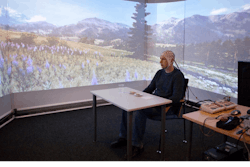
EAST LANSING, Mich. - The first-ever study of Michigan State University's pioneering robot-learning course shows that online students who use the innovative robots feel more engaged and connected to the instructor and students in the classroom.
Stationed around the class, each robot has a mounted video screen controlled by the remote user that lets the student pan around the room to see and talk with the instructor and fellow students participating in-person.
The study, published in Online Learning, found that robot learning generally benefits remote students more than traditional videoconferencing, in which multiple students are displayed on a single screen.
Christine Greenhow, MSU associate professor of educational psychology and educational technology, said that instead of looking at a screen full of faces as she does with traditional videoconferencing, she can look a robot-learner in the eye - at least digitally.
"It was such a benefit to have people individually embodied in robot form - I can look right at you and talk to you," Greenhow said.
The technology, Greenhow added, also has implications for telecommuters working remotely and students with disabilities or who are ill.
MSU's College of Education started using robot learning in 2015. Greenhow and Benjamin Gleason, a former MSU doctoral student who is now a faculty member at Iowa State University, studied an educational technology doctoral course in which students participated in one of three ways: in-person, by robot and by traditional videoconferencing.
Courses that combine face-to-face and online learning, called hybrid or blended learning, are widely considered the most promising approach for increasing access to higher education and students' learning outcomes. The number of blended-learning classrooms has increased dramatically in the past decade and could eventually make up 80 percent or more of all university classes, the study notes.
With traditional videoconferencing, Greenhow said, remote students generally can't tell the instructor is looking at them and can get turned off from joining the discussion. "These students often feel like they're interrupting, like they're not fully participating in the class. And as an instructor, that's like death - I can't have that."
"The main takeaway here," Greenhow added, "is that students participating with the robots felt much more engaged and interactive with the instructor and their classmates who were on campus."
To engage the robot from home, students just need to download free software onto their computer.






















